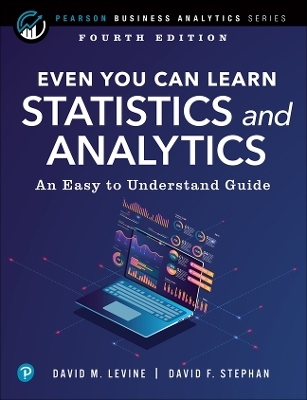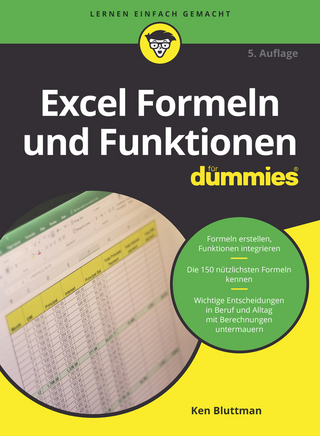
Even You Can Learn Statistics and Analytics
Addison Wesley (Verlag)
978-0-13-765476-5 (ISBN)
This book discusses statistics and analytics using plain language and avoiding mathematical jargon. If you thought you couldn't learn these data analysis subjects because they were too technical or too mathematical, this book is for you!
This edition delivers more everyday examples and end-of-chapter exercises and contains updated instructions for using Microsoft Excel. You'll use downloadable data sets and spreadsheet solutions, template-based solutions you can put right to work. Using this book, you will understand the important concepts of statistics and analytics, including learning the basic vocabulary of these subjects.
Create tabular and visual summaries and learn to avoid common charting errors
Gain experience working with common descriptive statistics measures including the mean, median, and mode; and standard deviation and variance, among others
Understand the probability concepts that underlie inferential statistics
Learn how to apply hypothesis tests, using Z, t, chi-square, ANOVA, and other techniques
Develop skills using regression analysis, the most commonly-used Inferential statistical method
Explore results produced by predictive analytics software
Choose the right statistical or analytic techniques for any data analysis task
Optionally, read the “Equation Blackboards,” designed for readers who want to learn about the mathematical foundations of selected methods
David M. Levine and David F. Stephan are part of a writing team known for their series of business statistics textbooks that include Basic Business Statistics, Business Statistics: A First Course, and Statistics for Managers Using Microsoft Excel. In long teaching careers at Baruch College, both were known for their classroom innovations, with Levine being honored with a Presidential Excellence Award for Distinguished Teaching Award and Stephan granted the privilege to design and develop the College's first computer-based classroom. Both are active members of the Data, Analytics and Statistics Instruction SIG of the Decision Sciences Institute. Levine is Professor Emeritus of Information Systems at Baruch College. He is nationally recognized innovator in business statistics education and is also the coauthor of Applied Statistics for Engineers and Scientists Using Microsoft Excel and Minitab. Levine is also the author or coauthor of four books about statistical quality management: Statistics for Six Sigma Green Belts and Champions, Six Sigma for Green Belts and Champions, Design for Six Sigma for Green Belts and Champions, and Quality Management, 3rd Edition. He has published articles in various journals, including Psychometrika, The American Statistician, Communications in Statistics, Multivariate Behavioral Research, Journal of Systems Management, Quality Progress, and The American Anthropologist, and has given numerous talks at American Statistical Association, Decision Sciences Institute, and Making Statistics More Effective in Schools of Business conferences. During his more than 20 years at Baruch College, Stephan devised techniques for teaching computer applications such as Microsoft Excel in a business context and developed future-forward courses that explored the effects of emerging digital technologies. He also served as the associate director of a U.S. Department of Education FIPSE project that successfully integrated interactive media into classroom instruction for the humanities.. Stephan is also the developer of PHStat, the statistics add-in for Microsoft Excel distributed by Pearson Education.
Introduction The Even You Can Learn Statistics and Analytics Owner's Manual. xiii
Chapter 1 Fundamentals of Statistics. 1
1.1 The First Three Words of Statistics. . . . . . . . . . . . . . . . . . . . . . . . . . . . . . . . . . 2
1.2 The Fourth and Fifth Words. . . . . . . . . . . . . . . . . . . . . . . . . . . . . . . . . . . . . . . 4
1.3 The Branches of Statistics. . . . . . . . . . . . . . . . . . . . . . . . . . . . . . . . . . . . . . . . . 4
1.4 Sources of Data . . . . . . . . . . . . . . . . . . . . . . . . . . . . . . . . . . . . . . . . . . . . . . . . 5
1.5 Sampling Concepts . . . . . . . . . . . . . . . . . . . . . . . . . . . . . . . . . . . . . . . . . . . . . 7
1.6 Sample Selection Methods. . . . . . . . . . . . . . . . . . . . . . . . . . . . . . . . . . . . . . . . 8
Chapter 2 Presenting Data in Tables and Charts . 15
2.1 Presenting Categorical Variables. . . . . . . . . . . . . . . . . . . . . . . . . . . . . . . . . . . 15
2.2 Presenting Numerical Variables . . . . . . . . . . . . . . . . . . . . . . . . . . . . . . . . . . . 23
2.3 “Bad” Charts. . . . . . . . . . . . . . . . . . . . . . . . . . . . . . . . . . . . . . . . . . . . . . . . . . 29
Chapter 3 Descriptive Statistics. 45
3.1 Measures of Central Tendency. . . . . . . . . . . . . . . . . . . . . . . . . . . . . . . . . . . . 45
3.2 Measures of Position. . . . . . . . . . . . . . . . . . . . . . . . . . . . . . . . . . . . . . . . . . . . 49
3.3 Measures of Variation. . . . . . . . . . . . . . . . . . . . . . . . . . . . . . . . . . . . . . . . . . . 54
3.4 Shape of Distributions. . . . . . . . . . . . . . . . . . . . . . . . . . . . . . . . . . . . . . . . . . 59
Chapter 4 Probability. 75
4.1 Events. . . . . . . . . . . . . . . . . . . . . . . . . . . . . . . . . . . . . . . . . . . . . . . . . . . . . . 75
4.2 More Definitions . . . . . . . . . . . . . . . . . . . . . . . . . . . . . . . . . . . . . . . . . . . . . . 76
4.3 Some Rules of Probability. . . . . . . . . . . . . . . . . . . . . . . . . . . . . . . . . . . . . . . . 78
4.4 Assigning Probabilities. . . . . . . . . . . . . . . . . . . . . . . . . . . . . . . . . . . . . . . . . . 81
Chapter 5 Probability Distributions. 87
5.1 Probability Distributions for Discrete Variables. . . . . . . . . . . . . . . . . . . . . . . . 87
5.2 The Binomial and Poisson Probability Distributions. . . . . . . . . . . . . . . . . . . . 93
5.3 Continuous Probability Distributions and the Normal Distribution . . . . . . . 100
5.4 The Normal Probability Plot. . . . . . . . . . . . . . . . . . . . . . . . . . . . . . . . . . . . . 108
Chapter 6 Sampling Distributions and Confidence Intervals. 121
6.1 Foundational Concepts . . . . . . . . . . . . . . . . . . . . . . . . . . . . . . . . . . . . . . . . 122
6.2 Sampling Error and Confidence Intervals. . . . . . . . . . . . . . . . . . . . . . . . . . . 125
6.3 Confidence Interval Estimate for the Mean Using the t Distribution (? Unknown). . . 128
6.4 Confidence Interval Estimation for Categorical Variables . . . . . . . . . . . . . . . 131
6.5 Confidence Interval Estimation When Normality Cannot Be Assumed. . . . . 134
Chapter 7 Fundamentals of Hypothesis Testing. 145
7.1 The Null and Alternative Hypotheses. . . . . . . . . . . . . . . . . . . . . . . . . . . . . . 145
7.2 Hypothesis Testing Issues. . . . . . . . . . . . . . . . . . . . . . . . . . . . . . . . . . . . . . . 147
7.3 Decision-Making Risks. . . . . . . . . . . . . . . . . . . . . . . . . . . . . . . . . . . . . . . . . 149
7.4 Performing Hypothesis Testing. . . . . . . . . . . . . . . . . . . . . . . . . . . . . . . . . . . 150
7.5 Types of Hypothesis Tests. . . . . . . . . . . . . . . . . . . . . . . . . . . . . . . . . . . . . . . 152
Chapter 8 Hypothesis Testing: Z and t Tests. 157
8.1 Test for the Difference Between Two Proportions . . . . . . . . . . . . . . . . . . . . . 157
8.2 Test for the Difference Between the Means of Two Independent Groups . . . . 163
8.3 The Paired t Test. . . . . . . . . . . . . . . . . . . . . . . . . . . . . . . . . . . . . . . . . . . . . . 168
Chapter 9 Hypothesis Testing: Chi-Square Tests and the One-Way Analysis of Variance (ANOVA). 183
9.1 Chi-Square Test for Two-Way Tables. . . . . . . . . . . . . . . . . . . . . . . . . . . . . . . 183
9.2 One-Way Analysis of Variance (ANOVA): Testing for the
Differences Among the Means of More Than Two Groups. . . . . . . . . . . . . . . 191
Chapter 10 Simple Linear Regression. 211
10.1 Basics of Regression Analysis . . . . . . . . . . . . . . . . . . . . . . . . . . . . . . . . . . . 211
10.2 Developing a Simple Linear Regression Model. . . . . . . . . . . . . . . . . . . . . . 214
10.3 Measures of Variation. . . . . . . . . . . . . . . . . . . . . . . . . . . . . . . . . . . . . . . . . 221
10.4 Inferences About the Slope. . . . . . . . . . . . . . . . . . . . . . . . . . . . . . . . . . . . . 226
10.5 Common Mistakes When Using Regression Analysis . . . . . . . . . . . . . . . . . 229
Chapter 11 Multiple Regression. 243
11.1 The Multiple Regression Model . . . . . . . . . . . . . . . . . . . . . . . . . . . . . . . . . 243
11.2 Coefficient of Multiple Determination . . . . . . . . . . . . . . . . . . . . . . . . . . . . 246
11.3 The Overall F Test . . . . . . . . . . . . . . . . . . . . . . . . . . . . . . . . . . . . . . . . . . . 246
11.4 Residual Analysis for the Multiple Regression Model . . . . . . . . . . . . . . . . . 247
11.5 Inferences Concerning the Population Regression Coefficients. . . . . . . . . . 248
Chapter 12 Introduction to Analytics. 259
12.1 Basic Concepts. . . . . . . . . . . . . . . . . . . . . . . . . . . . . . . . . . . . . . . . . . . . . . 259
12.2 Descriptive Analytics. . . . . . . . . . . . . . . . . . . . . . . . . . . . . . . . . . . . . . . . . 265
12.3 Typical Descriptive Analytics Visualizations. . . . . . . . . . . . . . . . . . . . . . . . 269
Chapter 13 Predictive Analytics. 279
13.1 Predictive Analytics Methods. . . . . . . . . . . . . . . . . . . . . . . . . . . . . . . . . . . 279
13.2 More About Predictive Models. . . . . . . . . . . . . . . . . . . . . . . . . . . . . . . . . . 281
13.3 Tree Induction. . . . . . . . . . . . . . . . . . . . . . . . . . . . . . . . . . . . . . . . . . . . . . 284
13.4 Clustering . . . . . . . . . . . . . . . . . . . . . . . . . . . . . . . . . . . . . . . . . . . . . . . . . 287
13.5 Association Analysis. . . . . . . . . . . . . . . . . . . . . . . . . . . . . . . . . . . . . . . . . . 290
Appendix A Microsoft Excel Operation and Configuration . 299
Appendix B Review of Arithmetic and Algebra. 301
Appendix C Statistical Tables. 311
Appendix D Spreadsheet Tips . 339
Appendix E Advanced Techniques. 343
Appendix F Documentation for Downloadable Files. 353
9780137654765, TOC, 4/25/2022
| Erscheinungsdatum | 07.06.2022 |
|---|---|
| Reihe/Serie | Pearson Business Analytics Series |
| Verlagsort | Boston |
| Sprache | englisch |
| Maße | 178 x 232 mm |
| Gewicht | 680 g |
| Themenwelt | Informatik ► Office Programme ► Excel |
| Mathematik / Informatik ► Mathematik ► Statistik | |
| Wirtschaft ► Volkswirtschaftslehre ► Ökonometrie | |
| ISBN-10 | 0-13-765476-6 / 0137654766 |
| ISBN-13 | 978-0-13-765476-5 / 9780137654765 |
| Zustand | Neuware |
| Haben Sie eine Frage zum Produkt? |
aus dem Bereich


